It’s no longer enough to secure top talent during the hiring process – you’ll also need a bulletproof employee onboarding program to keep them. Don’t believe us?
Ponder this – great onboarding leads to 69% of staff staying at a company for three years.
We understand that you’ll want to get your new employees up to speed as soon as possible.
But the evidence shows that onboarding is essential for setting up new hires for success – and to successfully ease them into their new role and organization.
In this article, discover the 10 best onboarding ideas as well as:
- What are the 5 C’s of onboarding?
- Why do companies skip new hire onboarding?
- What does a standard new employee onboarding process look like?
- The key differences between a good & bad onboarding program

What are the 5 C’s of onboarding?
Each of the 5 C’s of the employee onboarding programme covers the best practices to follow when bringing on a new hire. These are compliance, clarification, culture, connection, and check-back. Let’s take a closer look at what they mean:
#1 – Compliance, forms, and paperwork
From a legal standpoint, it’s essential to provide a proper and thorough introduction to the company. That includes knowledge of the relevant company policies, confidentiality, workplace harassment, and other specific rules and protocols of different departments.
While this type of information can seem mundane (read: boring paperwork); it’s a step that cannot be missed.
#2 – Clarification of role and expectations
Following on from the job description as advertised, hiring managers are expected to (re)introduce the expectations of the new role, as well as explain how it fits into the organizational structure and introduce who they might interact with most often.
Establishing goals and objectives for the first year should also be part of the clarification process. This allows the new hire to ask any questions they may have to ensure a full understanding of the role and what success looks like.
#3 – Culture fit in the company
During the interview process, candidates will have gotten a feel for the company’s culture. And once on board, new hires are expected to embrace and embody it. From learning the company’s history, mission, and vision to demonstrating their commitment.
It’s especially important for managerial positions, as they set an example for their staff to follow, as well as remote workers – where building that connection to the company and positive team culture can be more challenging.
#4 – Connection with new colleagues
Starting in a new company can also be overwhelming, with a lot to take on. To help new hires ease into their roles, building connections with mentors and the new manager, and introducing them to related groups of employees can be beneficial.
Scheduling these introductions in advance will help to lessen the initial feeling of being overwhelmed and increase employee engagement. Something as simple as an office tour – or even a virtual tour for remote employees – can help the new hires feel less awkward during their first week of work.
#5 – Checkback at regular intervals
Last but not least, it’s important to follow up with the new employee during their first 30 to 90 days. Many organizations implement a formal “First 90-day Plan” to set key milestones for this period.
Weekly 1:1’s with direct reports is another common tactic to regularly check in and see how the new hire is doing. As well as a crucial opportunity for the new hire to raise any questions or concerns as they settle in.
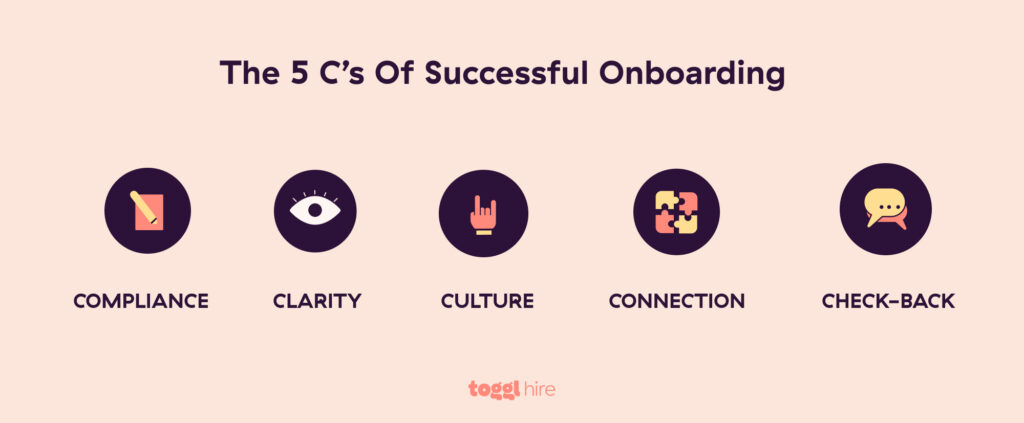
So, why do some companies skip new hire onboarding?
Skipping a new hire’s onboarding can have serious negative effects.
Onboarding not only helps newcomers to feel welcome, supported, and prepared for their role, but can also lead to higher employee retention, satisfaction, and performance.
Unfortunately, though, some organizations will skip this all-important step – usually due to one (or more) of the following reasons:
Time constraints
Yes, onboarding is a process that takes time, but so does everything else. If the company is hiring a large number of people in a short amount of time, this will take up valuable resources. Consider staggering new hires so that every employee can settle into the organization.
Consider staggering new hires so that every employee can settle into the organization without putting too much pressure on the current team members.
Budget constraints
It’s an expensive process, especially when there are new employees being hired constantly. Most companies keep an up-to-date employee manual or handbook, which can serve as a go-to knowledge base for new hires. Despite that, you’ll still need dedicated staff resources to assist and arrange intro meetings that typically eat into the productivity of veteran employees. But consider onboarding activities an investment, as the return almost always outweighs the cost.
Lack of understanding
Some organizations, especially newer start-ups without a well-established HR department, may not even realize the value of onboarding. To them and their stakeholders, it might seem like an unnecessary cost or burden. If that’s the case at your company, you have your work cut out. While it’s probably unnecessary to implement the onboarding practices of a large company, this article can help you prepare your shortlist of new employee onboarding ideas.
Poor planning
Without proper planning, companies may not have the resources or processes in place to successfully onboard new hires. This is no good, as poor planning will not go unnoticed, and can not only tarnish your reputation in the industry but also impact your ability to attract talent – or worse, retain the newly hired employees.
Employees will decide within 10 days if they intend to stay with the organization or begin looking for a different job.
Matt Vaadi, ERG Source
Onboarding is a common practice with almost all large companies. As a company grows, it becomes increasingly vital – and expected – to have a structured onboarding process in place. In fact, it’s unlikely that your organization will grow without one!
What does a standard new employee onboarding process look like?
Every company’s approach to onboarding will look a little different — it very much depends on the goal of the organization and the role of the new hire. However, there are five common elements that every single business should cover during the process:
1. Welcome and introductions
Make sure the entire organization welcomes the new employee, whether it be on your internal messaging system or in a video. Afterwards, schedule one-on-one introductions with key stakeholders and senior management. Just don’t do this all in one day!
2. Orientation
Outline the organization’s mission, values, and culture. And be sure to state any benefits, procedures, policies, and anything else that the new hire needs to know. This includes helping them familiarize themselves with their new environment – either in person or through a virtual tour.
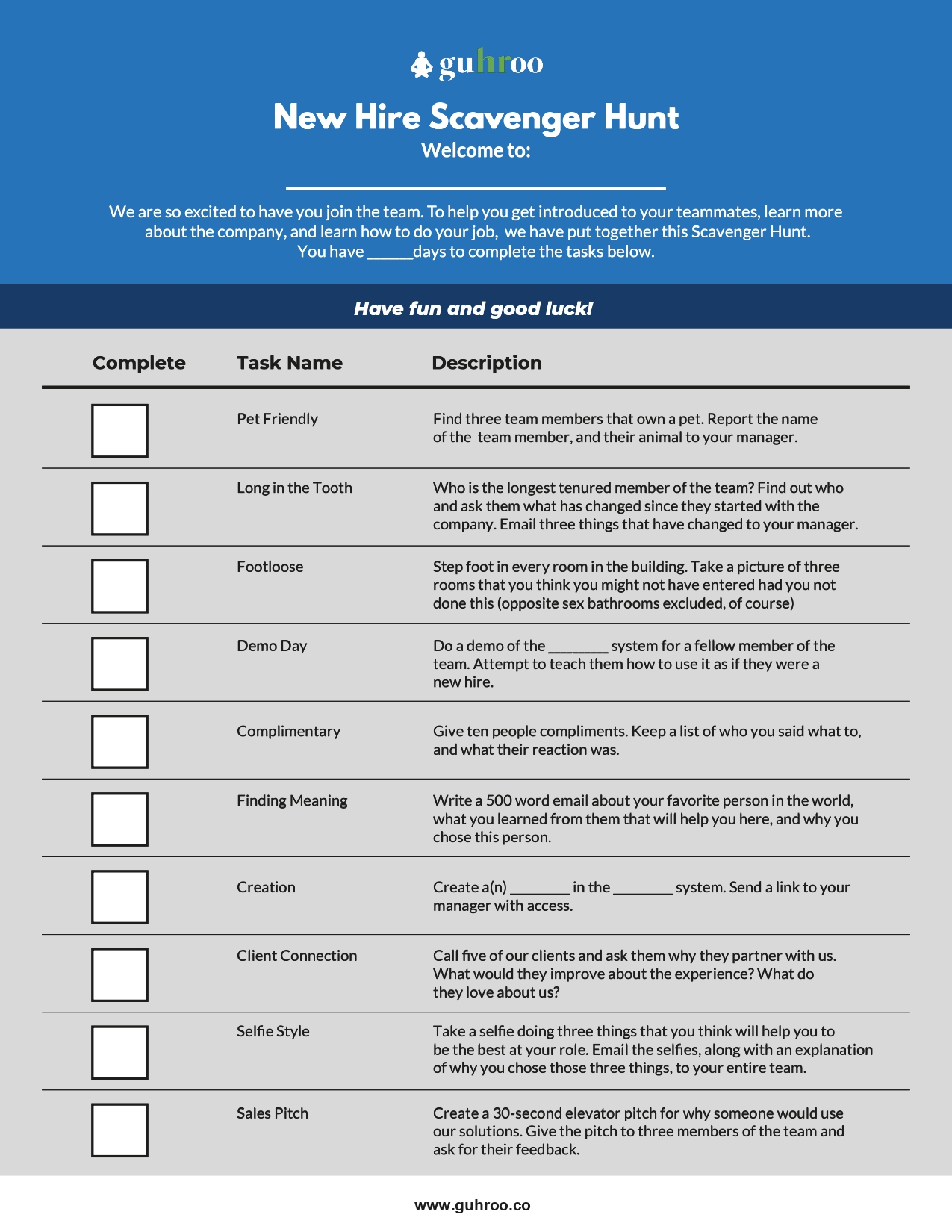
3. Training
Have the new hires complete a few tasks and for more junior roles, arrange for them to shadow some of the other employees. It will help them to obtain a better grasp of what is required of them.
4. Assimilation
Create onboarding activities geared towards helping new hires become familiar with their colleagues and the company culture, such as team-building exercises and social gatherings, like happy hour. This can also include team lunches, dinners, or other team-led activities.
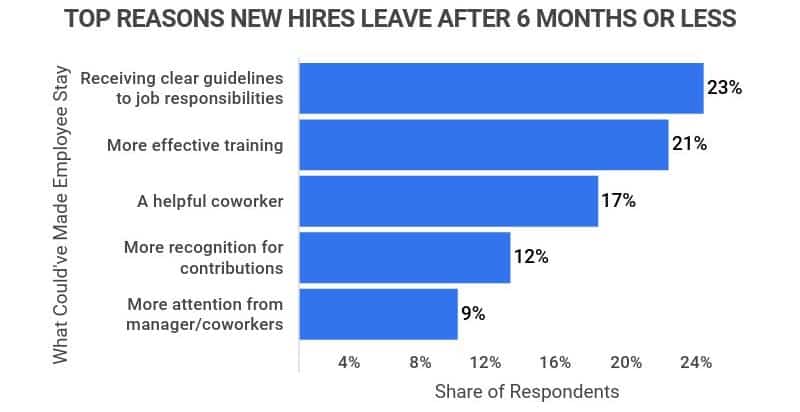
5. Support
Assign a supervisor, mentor, or buddy to the new member of staff who will help them learn the ropes, encourage them to grow, and act as a friend when they need one.
The key differences between a good & bad onboarding program
A successful and creative employee onboarding experience will help new hires transition into their roles and the company culture effectively. You can use this handy graphic as an onboarding checklist to make sure the process is up to snuff.
Essentially, the measure of a good onboarding experience is a satisfied employee. A common practice to help refine the process is to send out employee surveys to get new employees involved in sharing feedback. This can be especially helpful to get fresh onboarding ideas.
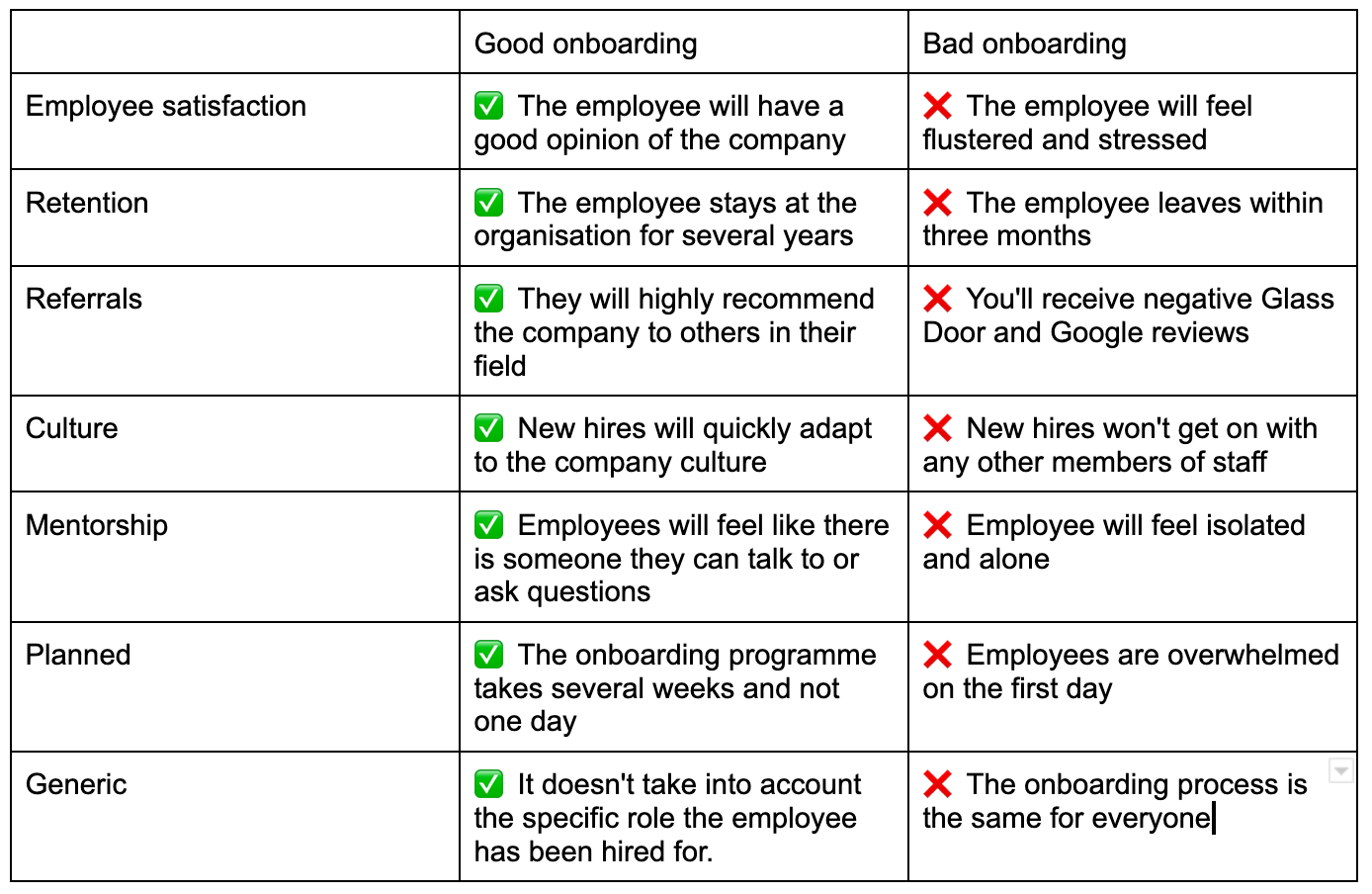
Top 10 creative employee onboarding ideas
Here are 10 of the best employee onboarding ideas that you can use to make your new joiners feel at home.
1. Assign a buddy
Tech giant Microsoft says that 97% of their new hires who met with their onboarding buddies eight times during the first few weeks had a boost in productivity.
Having a designated onboarding buddy (sometimes also known as culture buddy, leader buddy, or role buddy) is a great idea to help new joiners learn the ropes faster, get a feel for how their new team members like to work, and promote open and effective communication.
The buddy system isn’t difficult, but the right fit will go a long way to giving employees a good impression of the company.
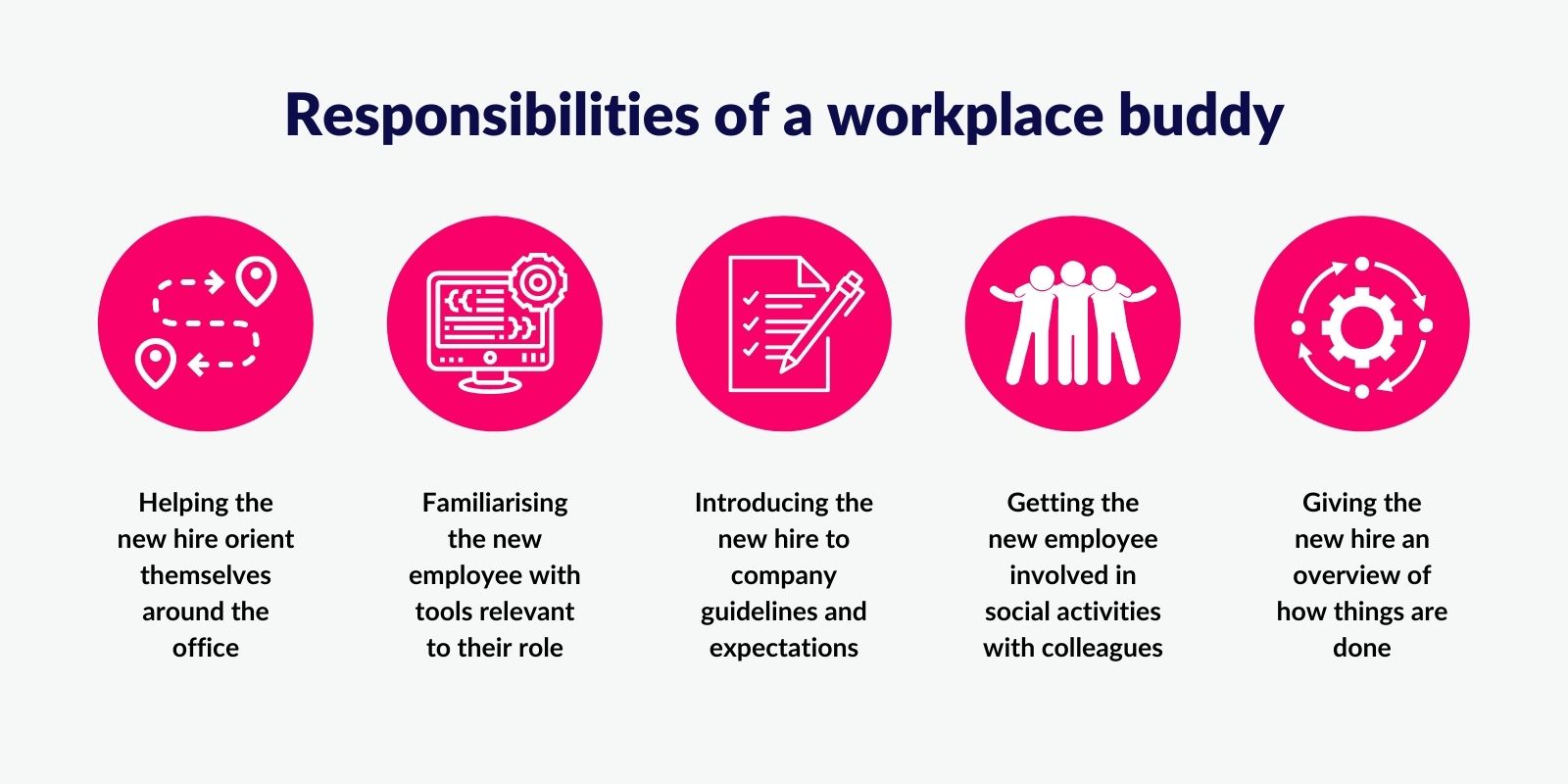
2. Send them a swag bag
Gifting new hires company merch or a swag bag can be a thoughtful way to make them feel welcome and part of the company culture from day one. It can also help to build a sense of pride and belonging among employees, contributing to a sense of camaraderie.
Your remote employees will love receiving a box of useful items and it’ll show them what a welcoming environment they are stepping into.
3. Prepare for their arrival ahead of time
Always ensuring new hires have the technology and equipment needed to do their job is a key part of successful onboarding.
Arrange for their tools to be provided in advance so new employees have everything they need before their first day. And don’t forget to set up their work email account as well.
No one wants to start a new job where they don’t have a computer, desk, or even a chair (this has happened to us). It just wastes everyone’s time.
4. Food brings people together

Welcoming new employees with lunch will show that they’re valued. Even bringing them their favorite breakfast food is a fun way to build connections. It is an opportunity for the new hire to become familiar with their colleagues in a less formal setting and get off on the right foot.
Having a meal together (or happy hour) can also be a great way to help them settle in and feel more comfortable with their new team. Remember, this is equally important for in-person and remote workers — even if the gathering takes place over a video call.
Idea! Get a few of the other departments in on the lunch and turn it into a full-blown social event.
5. Create a timetable for the first few days
It is helpful to create a schedule for new hires that includes an office tour, relevant training, and team meetings for the first few days. This helps the new hire to feel prepared and organized and ensures that they do not miss any important meetings or events.
Having a schedule already set up can also help to minimize any confusion or uncertainty during the employee onboarding stage.
6. Take things slow
Like holding a yoga pose, it’s worth remembering to go slow during the first week of a new hire’s employment. The focus should be on gaining a basic understanding of the company, not ambushing.
Immediately allocating tasks with tight deadlines or throwing the person into complex projects or meetings can greatly reduce their opinion of the organization.
7. Make introductions and stick around in meetings
Rather than throw your new hire into the deep end, the simple act of making introductions and attending their first few meetings can go a long way in making them feel supported.
Attending meetings together will help give the new hire’s manager some oversight of how they are doing and to ease any tensions or concerns between them and their new teammates.
8. Refer to the employee handbook
Eventually, every company reaches the point where they need an employee handbook. This little manual can help save time as well as standardize some of the onboarding procedures.
A good practice is to include a comprehensive checklist of every single thing the new hire needs to know, from emails to the tech stack. You can house all this information in a Google Doc, Notion page, or on the company intranet for quick and easy access.
9. Save time with structured onboarding
Another time-saving idea is to ensure all new employees receive a robust onboarding kit. Tools like HiBob can help streamline and optimize the process, making it more efficient for newbie employees.
HR will be able to ensure that the same standard of onboarding is provided to all new employees, regardless of their department, role, or location.
10. Scrutinise onboarding with feedback
No matter where you are in your onboarding journey, seeking constant feedback is the only way to make those continual, gradual improvements to your onboarding activities and process. This will make sure it’s always evolving and growing and tailored to fit your company’s unique office culture.
Acquire input from new hires and HR by conducting entry interviews as well as 30, 60, and 90-day surveys, and use that information to update your onboarding experience. And don’t forget about the exit interview when an employee leaves.

Make your new joiners feel welcome from day one
First impressions count, and thoughtful onboarding will help build strong relationships, retain top talent, and foster a positive work environment.
Putting effort into your onboarding ideas and process is essential for a successful hire. It sets the tone for the new employees’ experience with the company and can have an impact on their performance and retention.
By incorporating at least some of the above-mentioned onboarding ideas into the hiring process, you can help make sure it’s a positive employee experience from the start.
But if your company follows a robust employee onboarding process and still experiences slow ramp-up time, cultural misalignment, or poor employee performance – your recruitment process is most likely to blame. Read on to learn how talent assessments can help prevent bad hires.
James Elliott is a Strategy Manager and Writer from London, UK. When not working on the day job, James writes on a variety of business and project management topics with a focus on content that enables readers to take action and improve their ways of working. You can check out James’ work on his website or by connecting on LinkedIn.


